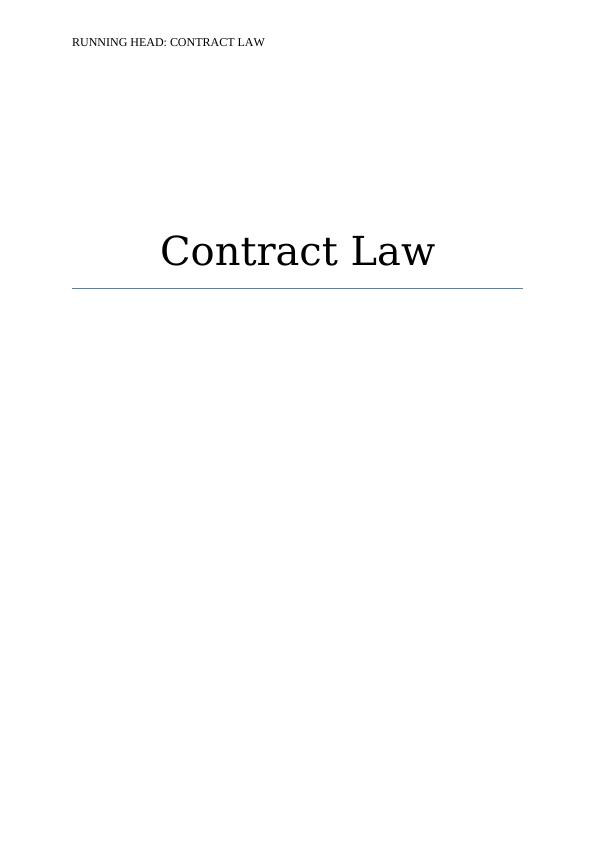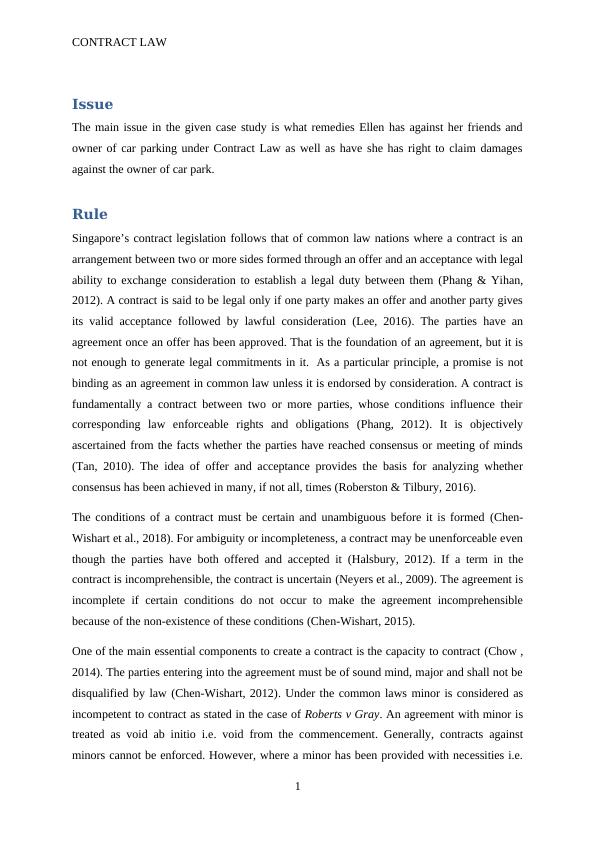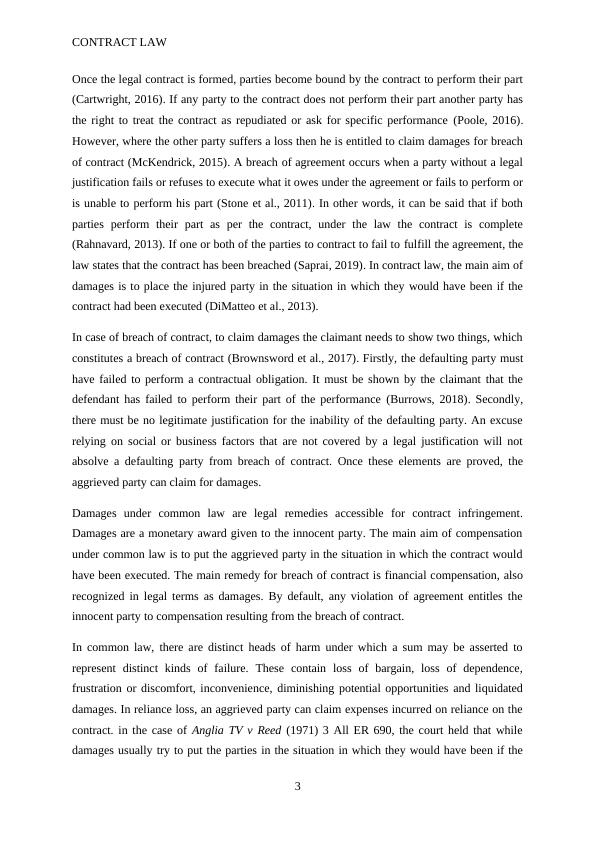Contract Law And Damages Analysis
This is a study guide for the Contract Law course in the Bachelor of Business Studies program at University College Dublin. It provides an introduction to the module, outlines the learning outcomes and assessment details, and includes a grading policy.
13 Pages4911 Words11 Views
Added on 2022-09-14
Contract Law And Damages Analysis
This is a study guide for the Contract Law course in the Bachelor of Business Studies program at University College Dublin. It provides an introduction to the module, outlines the learning outcomes and assessment details, and includes a grading policy.
Added on 2022-09-14
ShareRelated Documents
RUNNING HEAD: CONTRACT LAW
Contract Law
Contract Law

CONTRACT LAW
Issue
The main issue in the given case study is what remedies Ellen has against her friends and
owner of car parking under Contract Law as well as have she has right to claim damages
against the owner of car park.
Rule
Singapore’s contract legislation follows that of common law nations where a contract is an
arrangement between two or more sides formed through an offer and an acceptance with legal
ability to exchange consideration to establish a legal duty between them (Phang & Yihan,
2012). A contract is said to be legal only if one party makes an offer and another party gives
its valid acceptance followed by lawful consideration (Lee, 2016). The parties have an
agreement once an offer has been approved. That is the foundation of an agreement, but it is
not enough to generate legal commitments in it. As a particular principle, a promise is not
binding as an agreement in common law unless it is endorsed by consideration. A contract is
fundamentally a contract between two or more parties, whose conditions influence their
corresponding law enforceable rights and obligations (Phang, 2012). It is objectively
ascertained from the facts whether the parties have reached consensus or meeting of minds
(Tan, 2010). The idea of offer and acceptance provides the basis for analyzing whether
consensus has been achieved in many, if not all, times (Roberston & Tilbury, 2016).
The conditions of a contract must be certain and unambiguous before it is formed (Chen-
Wishart et al., 2018). For ambiguity or incompleteness, a contract may be unenforceable even
though the parties have both offered and accepted it (Halsbury, 2012). If a term in the
contract is incomprehensible, the contract is uncertain (Neyers et al., 2009). The agreement is
incomplete if certain conditions do not occur to make the agreement incomprehensible
because of the non-existence of these conditions (Chen-Wishart, 2015).
One of the main essential components to create a contract is the capacity to contract (Chow ,
2014). The parties entering into the agreement must be of sound mind, major and shall not be
disqualified by law (Chen-Wishart, 2012). Under the common laws minor is considered as
incompetent to contract as stated in the case of Roberts v Gray. An agreement with minor is
treated as void ab initio i.e. void from the commencement. Generally, contracts against
minors cannot be enforced. However, where a minor has been provided with necessities i.e.
1
Issue
The main issue in the given case study is what remedies Ellen has against her friends and
owner of car parking under Contract Law as well as have she has right to claim damages
against the owner of car park.
Rule
Singapore’s contract legislation follows that of common law nations where a contract is an
arrangement between two or more sides formed through an offer and an acceptance with legal
ability to exchange consideration to establish a legal duty between them (Phang & Yihan,
2012). A contract is said to be legal only if one party makes an offer and another party gives
its valid acceptance followed by lawful consideration (Lee, 2016). The parties have an
agreement once an offer has been approved. That is the foundation of an agreement, but it is
not enough to generate legal commitments in it. As a particular principle, a promise is not
binding as an agreement in common law unless it is endorsed by consideration. A contract is
fundamentally a contract between two or more parties, whose conditions influence their
corresponding law enforceable rights and obligations (Phang, 2012). It is objectively
ascertained from the facts whether the parties have reached consensus or meeting of minds
(Tan, 2010). The idea of offer and acceptance provides the basis for analyzing whether
consensus has been achieved in many, if not all, times (Roberston & Tilbury, 2016).
The conditions of a contract must be certain and unambiguous before it is formed (Chen-
Wishart et al., 2018). For ambiguity or incompleteness, a contract may be unenforceable even
though the parties have both offered and accepted it (Halsbury, 2012). If a term in the
contract is incomprehensible, the contract is uncertain (Neyers et al., 2009). The agreement is
incomplete if certain conditions do not occur to make the agreement incomprehensible
because of the non-existence of these conditions (Chen-Wishart, 2015).
One of the main essential components to create a contract is the capacity to contract (Chow ,
2014). The parties entering into the agreement must be of sound mind, major and shall not be
disqualified by law (Chen-Wishart, 2012). Under the common laws minor is considered as
incompetent to contract as stated in the case of Roberts v Gray. An agreement with minor is
treated as void ab initio i.e. void from the commencement. Generally, contracts against
minors cannot be enforced. However, where a minor has been provided with necessities i.e.
1

CONTRACT LAW
products or facilities appropriate for the lives of the minor involved to maintain the facility.
Minor under common law may avoid legal liability. A minor is not bound under the common
laws to perform his part of the contract (Holmes, 2018).
The other element, which determines the existence of a contract, is the intention to create
legal connections (Bernstein, 2018). An agreement, even if supported by consideration,
cannot be implemented in the lack of contractual intention (Gearey et al., 2013). It is a
question determined by an objective evaluation of the appropriate facts whether the parties to
an arrangement meant to establish legally binding relationships between them (Llewellyn,
2016). To establish an enforceable contract, an aim to establish legal relationships is essential
(Laws, 2014). An objective evaluation of the appropriate facts is to determine this (Poole,
2014). It is generally assumed that in personal and social agreements, parties do not wish to
establish lawful relationships (Dimatteo & Hogg, 2016). In contrast, it is usually assumed that
parties plan to establish a legal relationship in business contracts (Burnham, 2011).
The intention obligation to establish lawful connections in contract law is directed at
searching out occasions that are not appropriate for court interference (Fisher, 2018). Not
every agreement results in a binding contract that can be implemented by the courts (Austen-
Baker, 2017). The case of Balfour v Balfour (1919) 2 KB 571, is a leading case based on
intention to establish lawful relation and social agreement. In this case, it was determined by
the court that when the contract is domestic in nature, there is a rebuttable presumption
against an intention to establish a lawfully enforceable contract. Furthermore, the court stated
that the intention to create a lawful connection is a significant component of an agreement
and there is no intention of establishing a lawful connection in this situation. As the offer
taken in this case is a social agreement, it may also be observed that it is not a valid offer.
In the case of Jones v Padavatton (1968) EWCA Civ 4, it was held by the court that in this
case, no binding contract existed. Although an agreement would have existed if it were not
linked to domestic parties, there was insufficient evidence against domestic agreements to
rebut the presumption. The court further stated that there is a belief that family agreements
are founded on shared confidence, family ties, and friendship, and that there is no intention of
establishing legally binding agreements that can be enforced in court. However this
presumption may be rebutted, but the absence of formality concerning the mother-to-daughter
contract firmly stated that there was no such intention.
2
products or facilities appropriate for the lives of the minor involved to maintain the facility.
Minor under common law may avoid legal liability. A minor is not bound under the common
laws to perform his part of the contract (Holmes, 2018).
The other element, which determines the existence of a contract, is the intention to create
legal connections (Bernstein, 2018). An agreement, even if supported by consideration,
cannot be implemented in the lack of contractual intention (Gearey et al., 2013). It is a
question determined by an objective evaluation of the appropriate facts whether the parties to
an arrangement meant to establish legally binding relationships between them (Llewellyn,
2016). To establish an enforceable contract, an aim to establish legal relationships is essential
(Laws, 2014). An objective evaluation of the appropriate facts is to determine this (Poole,
2014). It is generally assumed that in personal and social agreements, parties do not wish to
establish lawful relationships (Dimatteo & Hogg, 2016). In contrast, it is usually assumed that
parties plan to establish a legal relationship in business contracts (Burnham, 2011).
The intention obligation to establish lawful connections in contract law is directed at
searching out occasions that are not appropriate for court interference (Fisher, 2018). Not
every agreement results in a binding contract that can be implemented by the courts (Austen-
Baker, 2017). The case of Balfour v Balfour (1919) 2 KB 571, is a leading case based on
intention to establish lawful relation and social agreement. In this case, it was determined by
the court that when the contract is domestic in nature, there is a rebuttable presumption
against an intention to establish a lawfully enforceable contract. Furthermore, the court stated
that the intention to create a lawful connection is a significant component of an agreement
and there is no intention of establishing a lawful connection in this situation. As the offer
taken in this case is a social agreement, it may also be observed that it is not a valid offer.
In the case of Jones v Padavatton (1968) EWCA Civ 4, it was held by the court that in this
case, no binding contract existed. Although an agreement would have existed if it were not
linked to domestic parties, there was insufficient evidence against domestic agreements to
rebut the presumption. The court further stated that there is a belief that family agreements
are founded on shared confidence, family ties, and friendship, and that there is no intention of
establishing legally binding agreements that can be enforced in court. However this
presumption may be rebutted, but the absence of formality concerning the mother-to-daughter
contract firmly stated that there was no such intention.
2

CONTRACT LAW
Once the legal contract is formed, parties become bound by the contract to perform their part
(Cartwright, 2016). If any party to the contract does not perform their part another party has
the right to treat the contract as repudiated or ask for specific performance (Poole, 2016).
However, where the other party suffers a loss then he is entitled to claim damages for breach
of contract (McKendrick, 2015). A breach of agreement occurs when a party without a legal
justification fails or refuses to execute what it owes under the agreement or fails to perform or
is unable to perform his part (Stone et al., 2011). In other words, it can be said that if both
parties perform their part as per the contract, under the law the contract is complete
(Rahnavard, 2013). If one or both of the parties to contract to fail to fulfill the agreement, the
law states that the contract has been breached (Saprai, 2019). In contract law, the main aim of
damages is to place the injured party in the situation in which they would have been if the
contract had been executed (DiMatteo et al., 2013).
In case of breach of contract, to claim damages the claimant needs to show two things, which
constitutes a breach of contract (Brownsword et al., 2017). Firstly, the defaulting party must
have failed to perform a contractual obligation. It must be shown by the claimant that the
defendant has failed to perform their part of the performance (Burrows, 2018). Secondly,
there must be no legitimate justification for the inability of the defaulting party. An excuse
relying on social or business factors that are not covered by a legal justification will not
absolve a defaulting party from breach of contract. Once these elements are proved, the
aggrieved party can claim for damages.
Damages under common law are legal remedies accessible for contract infringement.
Damages are a monetary award given to the innocent party. The main aim of compensation
under common law is to put the aggrieved party in the situation in which the contract would
have been executed. The main remedy for breach of contract is financial compensation, also
recognized in legal terms as damages. By default, any violation of agreement entitles the
innocent party to compensation resulting from the breach of contract.
In common law, there are distinct heads of harm under which a sum may be asserted to
represent distinct kinds of failure. These contain loss of bargain, loss of dependence,
frustration or discomfort, inconvenience, diminishing potential opportunities and liquidated
damages. In reliance loss, an aggrieved party can claim expenses incurred on reliance on the
contract. in the case of Anglia TV v Reed (1971) 3 All ER 690, the court held that while
damages usually try to put the parties in the situation in which they would have been if the
3
Once the legal contract is formed, parties become bound by the contract to perform their part
(Cartwright, 2016). If any party to the contract does not perform their part another party has
the right to treat the contract as repudiated or ask for specific performance (Poole, 2016).
However, where the other party suffers a loss then he is entitled to claim damages for breach
of contract (McKendrick, 2015). A breach of agreement occurs when a party without a legal
justification fails or refuses to execute what it owes under the agreement or fails to perform or
is unable to perform his part (Stone et al., 2011). In other words, it can be said that if both
parties perform their part as per the contract, under the law the contract is complete
(Rahnavard, 2013). If one or both of the parties to contract to fail to fulfill the agreement, the
law states that the contract has been breached (Saprai, 2019). In contract law, the main aim of
damages is to place the injured party in the situation in which they would have been if the
contract had been executed (DiMatteo et al., 2013).
In case of breach of contract, to claim damages the claimant needs to show two things, which
constitutes a breach of contract (Brownsword et al., 2017). Firstly, the defaulting party must
have failed to perform a contractual obligation. It must be shown by the claimant that the
defendant has failed to perform their part of the performance (Burrows, 2018). Secondly,
there must be no legitimate justification for the inability of the defaulting party. An excuse
relying on social or business factors that are not covered by a legal justification will not
absolve a defaulting party from breach of contract. Once these elements are proved, the
aggrieved party can claim for damages.
Damages under common law are legal remedies accessible for contract infringement.
Damages are a monetary award given to the innocent party. The main aim of compensation
under common law is to put the aggrieved party in the situation in which the contract would
have been executed. The main remedy for breach of contract is financial compensation, also
recognized in legal terms as damages. By default, any violation of agreement entitles the
innocent party to compensation resulting from the breach of contract.
In common law, there are distinct heads of harm under which a sum may be asserted to
represent distinct kinds of failure. These contain loss of bargain, loss of dependence,
frustration or discomfort, inconvenience, diminishing potential opportunities and liquidated
damages. In reliance loss, an aggrieved party can claim expenses incurred on reliance on the
contract. in the case of Anglia TV v Reed (1971) 3 All ER 690, the court held that while
damages usually try to put the parties in the situation in which they would have been if the
3

End of preview
Want to access all the pages? Upload your documents or become a member.
Related Documents
Business Law Assignment: Contract Formation and Promissory Estoppellg...
|7
|1937
|402
Assignment on Commercial Lawlg...
|9
|2937
|46
Assignment On Analysis Of Aspects Of Contractslg...
|12
|3463
|59
LAWS20061 Assignment - Assignment Management Lawlg...
|7
|1326
|89
The Contract Law of Australia - Assignmentlg...
|10
|2457
|144
Elements of a Contract and Intention to Create Legal Relationslg...
|9
|2810
|375
